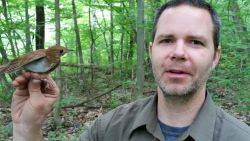Dr. Daniel Shustack
Professor, Environmental Studies

- daniel.shustack@mcla.edu
- Phone
- (413) 662-5301
- Office
- Center for Science & Innovation 225D
Education
Ph.D. in Natural Resources, School of Environment and Natural Resources, The Ohio State University
M.S. in Wildlife and Fisheries Biology, The Rubenstein School of Environment and Natural Resources
B.S. in Biology, The Pennsylvania State University
View my CV
Courses Taught
ENVI 150 Introduction to Environmental Systems
ENVI 152H Environmental Sustainability
ENVI 225 Nature of New England
ENVI/BIOL 315 Ornithology
ENVI 355 Everglades and South Florida
CCAP 305 Representations of Nature
Teaching
My courses revolve around the themes of wildlife biology, natural history, and environmental history. Some of my course, such as Ornithology and Nature of New England, are focused on wildlife biology. Other courses are strongly interdisciplinary and these include Landscape History, Everglades and South Florida and Representations of Nature. In all my courses, I hope students will develop in their knowledge and appreciation of the natural world as they pursue their professional and personal ambitions related to the environment. Students who take my courses should be ready to spend our lab periods in the field, no matter the season! MCLA is located in the heart of the Berkshires, an ideal place to pursue Environmental Studies. Our campus is surrounded by endless deciduous and coniferous forests, streams, rivers, fields, wetlands, lakes, all of which we visit, study and use during my courses. All of my courses in the Environmental Studies department and the Core Curriculum are open to any students who have satisfied the prerequisites.
Research
My research focusses on wildlife, especially songbirds in the forests of the northeast. My projects attempt to answer questions related to avian natural history, ecology, and migration. Since 2017, my students and I have been catching and banding dark-eyed juncos in western Massachusetts across all seasons so we can understand their morphological variation, winter habitat use, summer and winter site-fidelity, and migratory movements. Dark-eyed Juncos, like many bird species in North America, have experienced dramatic population declines (>30%) in recent decades. Our research is helping provide information that can be used to conserve this species. I also have other ongoing projects on Northern Cardinal coloration, migratory movements of Northern Saw-whet owls, and wintering populations of Evening Grosbeaks
Publications
Selected Research Publications
Shustack, D.P. and H. L. Wait (2023). Breeding Dark-eyed Junco (Junco hyemalis hyemalis) subspecies in western Massachusetts has not changed over previous 80 years. Wilson Journal of Ornithology 135:512-519.
Halkin, S. L., D. P. Shustack, M. S. DeVries, J. M. Jawor, and S. U. Linville (2021). Northern Cardinal (Cardinalis cardinalis), version 2.0. In Birds of the World (P. G. Rodewald and B. K. Keeney, Editors). Cornell Lab of Ornithology, Ithaca, NY, USA.
Hudon, J., R. J. Driver, N.H. Rice, T.L. Lloyd-Evans, J.A. Craves and D.P. Shustack. 2016. Diet explains red flight feathers in Yellow-shafted Flickers in eastern North America. Auk: Ecological Advances 134:22-33.
Rodewald, A. D., L.J.Kearns, and Shustack, D. P. 2013. Consequences of urbanizing landscapes to reproductive performance of birds in remnant forests. Biological Conservation 160:32-39.
Shustack, D.P. and A.D. Rodewald. 2011. Nest predation reduces benefits to early clutch initiation in northern cardinals Cardinalis cardinalis. Journal of Avian Biology 42:204-209.
Scientific Presentations
*denotes undergraduate researcher
Using Motus to determine Dark-eyed Junco migration strategies. D.P. Shustack, AFO-SOC-WOS Joint Ornithological Meeting (2024).
Dark-eyed Juncos (Junco hyemalis hyemalis) in western Massachusetts include year-round residents, winter residents, and migrants. D.P. Shustack, E.J. Neumuth, and H.L. Wait*, Association of Field Ornithologists Annual Meeting (2022).
Connecting Flock Size and Overwintering Habitat Use in North Adams, MA. L.G. deLemos* and D.P. Shustack, Northeast Natural History Conference (2022).
Breeding habitat use during migration by Junco hyemalis (Dark-eyed Juncos) in western Massachusetts. H.L. Wait* and D.P. Shustack, Northeast Natural History Conference (2022).
Veery (Catharus fuscescens) Nest Composition and Structure. S.C. Paulsen* and D.P. Shustack, Wilson Ornithological Society Annual Meeting (2021).
Feather Coloration in Junco hyemalis (Dark-eyed Juncos). S.C. Welch* and D.P.Shustack. Wilson Ornithological Society Annual Meeting (2021).
Bird Banding Records Demonstrate That Some Northern Cardinals Disperse Long Distances. D. P. Shustack, 27th Annual Meeting of the Wildlife Society (2020).
Using the USGS Bird Banding Lab Database to Assess Dispersal in Northern Cardinals
(Cardinalis cardinalis). D. P. Shustack, 7th North American Ornithological Congress (2020).
Invited And Outreach Presentations
Bird Conservation: We are not Finished. Berkshire Botanical Gardens Opening of the Lost Bird Project, August 2024
Simply complex: Outwitting and Being Outwitted by a Literal Bird Brain. MCLA Founder’s Weekend, June 2022
Should I stay or should I go? Migration and ecology of the dark-eyed Junco, MCLA Homecoming. October 2020
Well-kept secrets of our juncos, Hoffman Bird Club. September 2020.
